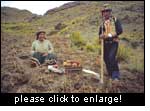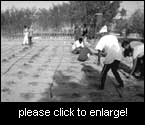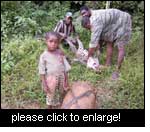 |
|
| Your
source of information on natural resources in international cooperation - focusing on agriculture, forestry and environment |
| Home | Research Service | Publications | About InfoResources | Contact | Français | Español |
| Publications > |
InfoResources News No 4 / 03 (December 2003)Special feature Special FeatureGender and natural resource management: Where do we stand?
But important preconditions for monitoring are still lacking. There is a great shortage of systematic sex-disaggregated data in the area of natural resource management (NRM). As a result, long-term monitoring indicators are lacking. Consequently, the FAO’s Gender and Population Division developed six gender-sensitive socio-economic indicators based on both quantitative and qualitative data. This should make it possible, for example, to monitor changes in descriptions of natural resources given by women and men, changes in access to agricultural inputs and land, and the ways in which indigenous knowledge about natural resources develops among men and women. The indicators should help in analysing project impacts and in monitoring genderspecific changes in the management of natural resources over time. Brief methodological suggestions are made about the data needed to establish indicators, and how indicators are to be interpreted. In addition to monitoring, practical implementation of a gender mainstreaming approach remains a major challenge. Implementation efforts continually encounter institutional, methodological and social obstacles. With the aim of overcoming these difficulties, the Swiss Agency for Development and Cooperation (SDC), in conjunction with the publication of its gender policy, recently issued a gender mainstreaming tool kit. The tool kit will assist SDC staff and their partner organisations in integrating gender as a transversal theme at all levels of policy development, including project work in the field. Initial experience indicates that the worksheets containing key, practice-oriented questions are a helpful checklist for use in daily work. Sources: Of current interest: Policy Will supermarkets soon control agriculture in the South? Supermarkets are experiencing a boom in developing countries. The proportion of the poor population who purchase food in supermarkets is growing rapidly. Supermarkets accounted for about 50% of retail food sales in Latin America in the 1990s. This revolutionary change is progressing even more rapidly in Africa. Globalisation and urbanisation are creating optimal conditions for a few multinational chains such as Ahold, Carrefour and Wal-Mart. When purchasing goods, supermarkets can make demands with respect to quantity and quality that can not be met by smallholders. Yet supermarkets are not dependent on local producers. Consequently, unless they have some form of support, smallholders are excluded from the market. This was the conclusion of participants at a workshop on agrifood systems in developing countries conducted by the FAO in October. Farmers require training and financial resources if they are to be able to compete in a radically changed market. They need to organise themselves into cooperatives and be capable of engaging in complex negotiations with new customers. The authors of an article in Development Policy Review predicted that only farmers who can obtain international assistance in supplying a large quantity of products of certified quality throughout the year will have a chance to compete. In a study scheduled for publication in December in the American Journal of Agricultural Economics, the authors call for a revision of development strategy in the small farm and small and medium enterprise sector for the same reasons. Sources: Population growth and/or the marginalisation of smallholders and pastoralists since colonisation were long held responsible for degradation in dryland areas. The poverty assumed to be linked with this process was identified as a reason for further exploitation of natural resources and desertification. Avoiding an environmental crisis and improving local environmental conditions became the central focus of development efforts. A Noragric Working Paper examined this simplified explanation. Dryland areas are known to be regions that are subject to great natural fluctuations. Populations in these areas have traditionally adapted to these conditions. It is not scarce resources that force local populations to exploit natural resources in an unsustainable way, but institutional and market failures that make overexploitation necessary. The authors conclude with a demand that improvement in local livelihoods, rather than environmental improvement, be put at the centre of development efforts. Measures to this end are needed not only with respect to protecting local resources, but also primarily with respect to national and institutional conditions. Source: Poverty and Environmental Degradation in the Drylands: An Overview of Problems and Processes. S. Movik, S. Dejene and G. Synnevåg. Noragric Working Paper No. 29, 2003. 50 p. www.nlh.no/noragric/publications/workingpapers/noragric-wp-29.pdf
For the first time, a publication has addressed the range of different aspects involved in governance of environmental resources. The report World Resources 2002-2004 benefited from contributions made during the World Summit on Sustainable Development in Johannesburg in 2002, which were integrated into its final version. This report introduces the topic, describes both prerequisite and essential stages in environmental governance, and then re-examines them at the international level and through local case studies. The ninth and final chapter is a synthesis of measures needed to achieve equitable environmental governance. In particular, decision-making should be beneficial to the health of ecosystems, foster social equity, and promote a sound economy, which is not currently the case in most countries of the world. The chapter concludes by presenting an original selection of the different recommendations and opportunities that came to light at Johannesburg, and describes the actions that need to be taken by each group of actors interested in working towards implementation of these recommendations. Source: World Resources 2002 – 2004: Decisions for the Earth: Balance, Voice and Power. UNDP, UNEP, World Resources Institute, 2003. 315 p. http://pubs.wri.org/pubs_description.cfm?PubID=3764 The International Centre for Agricultural Education (CIEA) organises periodic seminars at various venues around the world. In October 2003, future-oriented models and strategies for agricultural training at the secondary level were discussed in San Felipe, Chile. The focus was on didactic methodology as well as aspects of academic policy and organisation. Among other things, three major challenges related to improved training in rural areas were highlighted at the conclusion of discussions: 1) The search for new forms of cooperation between state educational institutions and private enterprise; 2) The growing shift from teacher-centred instruction to teaching-learning processes in which the concerns, potentials and activities of students are at the centre of didactic decision-making; 3) New forms of student and teacher assessment that employ different methods and different perspectives. It was crucial to the success of the seminar that ideas were not only brought forth in the plenary sessions but later in situ, in agricultural schools where they could be directly scrutinized and analysed. The participants, who came from 15 countries in Latin America, were thus able to return home with concretely formulated projects that could bring about change in their own countries. Sources: CIEA Seminar: ”Enfoques Estratégicos y Pedagógicos para la capacitación agrícola en el marco de la globalización.” San Felipe, Chile, 6 –17 october 2003. www.ciea.ch/ac_past.htm Contacts: roland.staehli@shl.bfh.ch and heidi.huerlimann@blw.admin.ch In InfoResources News No 3/03 we announced the conference entitled ”Beyond carbon – emerging markets for ecosystem services”. More than 200 representatives from the private sector, environmental organizations, research and academic institutions, governments and development agencies explored the potential of emerging markets for environmental services such as watershed management, biodiversity conservation and carbon sinks. Links between these markets, sustainable development and the Millennium Goals were central issues debated at the conference. Lessons learned in pilot projects – for example in Colombia and Australia – as well as through the Prototype Carbon Fund of the World Bank illustrated some important potential benefits, risks and challenges of these markets. Among the significant outputs of this conference are: Swiss Re’s commitment to becoming carbon neutral and the launching of the campaign ”Forest Carbon and the Millennium Development Goals: Using carbon markets to reduce rural poverty and conserve biodiversity”. Further important assets of the conference were the exchange of knowledge and experience; two workshops offered project developers and possible investors a great opportunity to establish contacts. Information: www.katoombagroup.com/Katoomba/meetings/katoomba6.htm Of current interest: Implementation Modelling natural resource management: An instrument for negotiation The many people involved in natural resource management are found at various hierarchical levels. As external actors, development agents in principle can only try to facilitate the process of negotiation among those directly involved in resource management. Analysis of ”mental models” – i.e. understanding the strategies of the various actors – is necessary to facilitate negotiations. The article cited here presents an integrated model used to facilitate negotiations in Indonesia. It classifies variables into categories such as productivity, biodiversity, sustainability, fires and carbon stocks, hydrological functions, knowledge, and ethical and aesthetic values. It advances through the following stages: formulation of the problem; presentation of alternatives; making a diagram of causal relationships; quantitative modelling; implementation and validation of the model; evaluation of alternatives by actors; and finally, negotiations. During this process synergies among actors are clarified and innovations proposed with a view towards conciliation. But the main purpose is to identify issues that require compromise. The book and the article which is excerpted from it, both address resource managers confronted by obstacles that go beyond technical aspects. The methods proposed make it possible to put actors on a roughly equal footing in terms of providing ”pre-analysed” information. Source: Negotiation Support Models for Integrated Natural Resource Management in Tropical Forest Margins. M. Van Noordwijk, T. P. Tomich, B. Verbist. In: Integrated Natural Resource Management – Linking Productivity, the Environment and Development. Campbell, B. M. and Sayer, J. A. Eds., 2003. p. 87-108
Material of high quality, comprehensive extension services, and years of supervising farmers are essential for successful application of this technology. The irrigation kits employed are small, allowing initial investment by farmers to remain low. This hardly permits them to produce for the market; the focus is rather on improving the food supply for farm households. The price and amount of available water are crucial factors in acceptance of this technology. When water is available throughout the year, farmers see little advantage in adopting a new system. But when this system makes irrigation possible during the dry season, it is more attractive. The study cited here, done in Eritrea, identifies home gardens in peri-urban areas as a particularly suitable context for introducing small-scale micro irrigation. Women are an especially important target group, as they usually tend the gardens and are not allowed to plough fields – a task that is not required with use of this technology. Source: Small-scale Micro Irrigation in Eritrea. A feasibility study on the introduction of affordable micro irrigation technology in Eritrea. Brigitta Stillhardt, Bissrat Ghebru, Abraham Mehari Haile. 2003., 83 p. Successful communication is of central importance in natural resource management (NRM). Whereas, people were previously informed and convinced, the importance of communication now lies primarily in involving local actors and enabling them to effect changes in the community as well as in external conditions. Increasing pressure on natural resources and changes of the media as a result of liberalisation and new technologies are posing ever greater challenges to communication. The Communication Initiative and the FAO’s Communication for Development Group have developed a tool for interested parties involved in efforts to improve communication related to NRM. Starting with theoretical approaches, readers are confronted with concrete cases and must actively analyse particular communication situations. Thus, for example, the Panos Pastoralist Communication Project in Kenya is used as a stimulus for reflecting on how certain actors might best exchange information, and how public authorities and policy-makers provide information about issues that concern them. The book is not meant for quick reading, but requires in-depth, active engagement with the issue. Source: Communication and Natural Resource Management: Experience - Theory. The Communication Initiative and the Communication for Development Group. FAO 2003. 98 p. ftp://ftp.fao.org/docrep/fao/005/y4737E/y4737E00.pdf Of current interest: Research Virtual water: A new concept
The concept of virtual water is of interest when related to agricultural trade and consumption. In terms of comparative advantage, countries with water shortages could import products whose production requires large amounts of water, and export products that require little water for production. This would allow these countries to save water that could be made available for other uses. Trade in virtual water could be influenced by greater awareness among consumers. The concept of virtual water also raises questions: is it ecologically reasonable to transport more products around the world? And: is complete dependency on importation of certain foods desirable for a country? Source: "Wasser im
Essen". Presentation by Dr. Christoph Studer at the symposium
"Ohne Wasser keine Nahrung" October 18th, 2003, Zollikofen
(Switzerland). www.infoagrar.ch/wasser-symposium/images/
The authors of this article use two criteria as a basis for arguing in favour of considering the role of bushmeat in development policy from a ”humanist” rather than a ”conservationist” perspective. Bushmeat undoubtedly helps improve the conditions of life at the local level and, where legitimate open markets exist, it can also enhance the conditions for good forest management. Putting these arguments into practice in some regions would appear to contradict significant efforts being made to limit the hunting of certain species. Such a change of attitude on the part of the government could be a source of confusion and constitute a threat to control of local government offices and to good governance. Nevertheless, it is clear that the need to alleviate poverty, as well as certain ethical considerations (rights of indigenous peoples), should stimulate research to evaluate the potential for active animal management, including possible forms of domestication or substitution. Sources: The case for bushmeat as a component of development policy: issues and challenges. D. Brown and A. Williams. In: International Forestry Review 5 (2), 2003. p. 148-155
|



